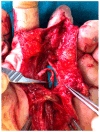The Recurrence of Painful Neuromas of the Limbs Following TMR
- PMID: 40004609
- PMCID: PMC11856367
- DOI: 10.3390/jcm14041078
The Recurrence of Painful Neuromas of the Limbs Following TMR
Abstract
Background/Objectives: Neuropathic pain associated with neuromas is a complex clinical problem to treat. Targeted Muscle Reinnervation (TMR) has been demonstrated to treat pain both as a prophylactic procedure in amputated patients and in patients affected by painful neuromas. It is not clear what its role could be in chronic situations: the literature reports amazing results but also unsuccessful pain relief. Methods: A retrospective analysis was conducted on patients treated with TMR for long-lasting painful neuromas in the upper and lower limbs. Following a clinical and instrumental diagnosis, all patients responded positively to a local anesthetic block. During follow-up visits, the NRS and DN4 questionnaires were used to assess improvement in pain. Results: Three patients were included in this study. TMR was performed 45 months after trauma. Two TMRs involved nerves of the upper extremity, in one case, the tibial nerve. The recipient muscles were the second lumbricalis, pronator quadratus, and flexor digitorum longus of the foot. After surgery, pain decreased for 3 months, but patients experienced a relapse that returned to levels close to the pre-operative period. The types of pain, as reported in DN4 questionnaire, changed slightly compared to those in the pre-surgical period. Follow-up ranged between 12 and 19 months. Conclusions: This small series collected the results of TMR in patients affected by long-lasting symptomatic neuromas in the upper and lower extremities. Despite what is published in other series, this procedure reduced pain for up to 6 months. At final follow-up, the type of pain changed slightly as reported in the DN4 questionnaire, and pain scores reduced by just one point as shown by the NRS. Our experience suggests that TMR might have a slight effect on long-lasting painful neuromas and in these cases, only short-term pain relief could be expected. This suggests using TMR as close as possible to the trauma in order to increase the chances of relieving pain.
Keywords: TMR; chronic pain; nerve injury; painful neuroma.
Conflict of interest statement
The authors declare no conflicts of interest.
Figures


Similar articles
-
Targeted Muscle Reinnervation for the treatment of painful neuromas: a prospective cohort study.Plast Reconstr Surg. 2025 Apr 9. doi: 10.1097/PRS.0000000000012152. Online ahead of print. Plast Reconstr Surg. 2025. PMID: 40209045
-
Targeted Muscle Reinnervation Using the Anterior Interosseous Nerve for Symptomatic Wrist Level Neuromas.Hand (N Y). 2025 May 22:15589447251339506. doi: 10.1177/15589447251339506. Online ahead of print. Hand (N Y). 2025. PMID: 40400359 Free PMC article.
-
Targeted Muscle Reinnervation at the Time of Amputation Decreases Recurrent Symptomatic Neuroma Formation.Plast Reconstr Surg. 2024 Jan 1;153(1):154-163. doi: 10.1097/PRS.0000000000010692. Epub 2023 May 18. Plast Reconstr Surg. 2024. PMID: 37199690
-
Update/Refinement of Targeted Muscle Reinnervation Indication: A Scoping Review of Applications for Non-Amputees.J Clin Med. 2024 Oct 14;13(20):6107. doi: 10.3390/jcm13206107. J Clin Med. 2024. PMID: 39458057 Free PMC article.
-
Targeted Muscle Reinnervation: A Paradigm Shift for Neuroma Management and Improved Prosthesis Control in Major Limb Amputees.J Am Acad Orthop Surg. 2021 Apr 1;29(7):288-296. doi: 10.5435/JAAOS-D-20-00044. J Am Acad Orthop Surg. 2021. PMID: 33405489 Review.
References
LinkOut - more resources
Full Text Sources

